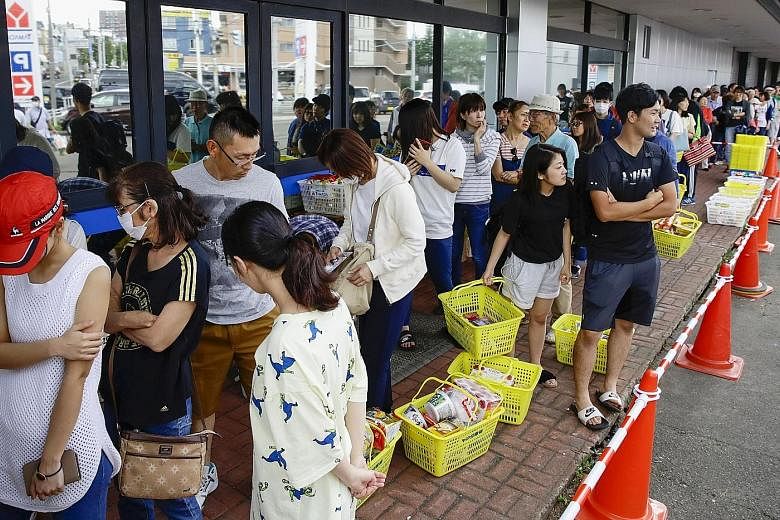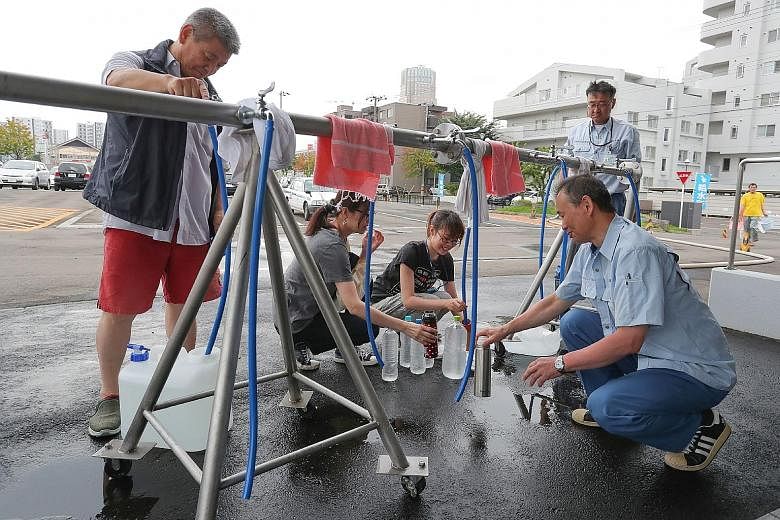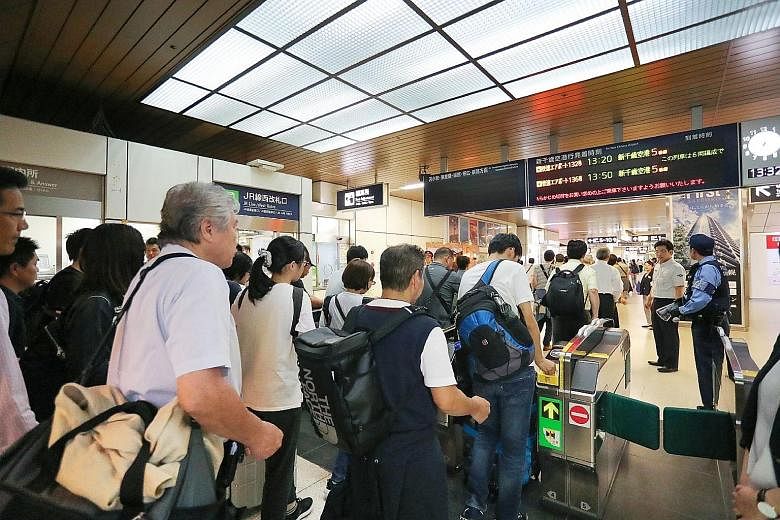Public transport services were halted city-wide after major tremors shook Osaka in June and Hokkaido last week. But, in both places, that did not stop salarymen and women in their customary dark suits making their way to work - some by walking for at least an hour.
Orderly queues formed outside convenience stores and supermarkets that remained open, with stoical residents stocking up on necessities.
Despite the massive inundation across wide areas of western Japan, or the sudden landslides that flattened homes after "historic" rainfall in July, many people chose to stay put and rebuild their lives.
The summer this year has been brutal even by Japanese standards. The nation, which is prone to natural disasters, was not only battered by two major earthquakes and the strongest typhoon in 25 years, but also had to endure historic rainfall and unrelenting heat.
Yet, through it all, the renowned resilience of the Japanese was on display, encapsulated by their mantra "shikata ga nai" or "sho ga nai", which loosely translates as "it cannot be helped" or "there is no other way". This outlook has guided a nation that designated Sept 1 as Disaster Prevention Day to mark the Great Kanto Earthquake on that day in 1923 that devastated Tokyo and killed over 140,000 people.
But given Japan's size, chances are that someone in Tokyo will be far removed from a major disaster that hits, say, Hokkaido or Osaka. There is also a tendency to believe that one will not experience any major disaster event in his or her lifetime, given that it rarely occurs at the same place with the same intensity. Professor Naoshi Hirata, who heads the government's Earthquake Research Committee, told a media briefing last year that this is the reason why some people loosen their guard and react in the event of an earthquake by saying that they "never expected it to take place in their lifetime".
This attitude is the flipside of shikata ga nai, manifest in how some choose to ignore non-mandatory evacuation orders as they downplay the potential severity of a disaster by comparing it to their previous experiences. Experts have pointed to this as the reason the recent heavy rains left at least 225 people dead in the flooding and landslides that ensued. Another offshoot of shikata ga nai is that many have come to believe that they can run but can't hide.
Japan is a hotbed of seismic activity and accounts for 20 per cent of the world's earthquakes with magnitudes of at least 6.0. It is also shaken by about 1,500 quakes every year, though most are minor.
The country of 126.7 million people also gets battered by typhoons. But with 73 per cent of its terrain mountainous, many areas are either built on, or hemmed in by, steep slopes that can put homes in the path of landslides.
Such communities usually comprise ancestral homes, and are ripe for farming. The cities, meanwhile, are typically coastal and low-lying, making them vulnerable to flooding.
But "strong building codes and resilient engineering practices across a majority of the country" have helped to mitigate disasters, risk modelling consultancy RMS said in a report last week. The Land, Infrastructure, Transport and Tourism Ministry has sought a 19 per cent budget increase for fiscal 2019 to fund improvements to ageing infrastructure to cope with more severe events.
Brutal summer of quakes, heatwave, rains and typhoon
Japan may be prone to natural disasters, but the summer of 2018 will go down in the history books as an exceptionally brutal one because of a series of extreme events that have rewritten records. Here's a look at what the Japanese have had to weather since June.
OSAKA EARTHQUAKE, JUNE 18
* Five dead, over 400 injured.
* Strongest tremor in Osaka since records began in 1923.
The magnitude 6.1 quake brought Japan's secondlargest metropolitan area to a halt during the morning rush, sparking panic and a surge in fake news which included allegations that foreigners were looting buildings and poisoning water sources.
HISTORIC RAINFALL, JULY 6-8
* About 225 dead in 15 prefectures in western and south-western Japan, with about 10 still missing, due to massive flooding and landslides.
* The deluge set 72-hour precipitation records with many areas receiving up to three times the average monthly rainfall for July.
Hiroshima and Okayama prefectures were the hardest hit as tens of thousands were displaced by floodwaters that were over onestorey high or landslides that crushed entire homes. At one point, evacuation orders or advisories were issued for up to 5.9 million people in 19 prefectures.
EXTREME HEATWAVE, JULY TO AUGUST
* At least 133 dead, more than 55,000 treated for heat exhaustion.
* The mercury reached 41.1 deg C in Kumagaya in the Greater Tokyo region on July 23, a national record.
* The Japan Meteorological Agency said 2018 was the hottest summer for eastern Japan since 1946.
TYPHOON JEBI, SEPT 4
* At least 11 dead, over 600 injured.
* Strongest typhoon to hit Japan in 25 years paralysed major cities in the Kansai region, including Osaka, Kyoto and Kobe.
About 8,000 passengers were stranded at the inundated Kansai Airport, which is built on a manmade island. Flights were cancelled as runways were flooded. It was also impossible to return to the city centre as the only bridge connecting the airport to the mainland was damaged after a tanker slammed into it during the storm.
The airport has since been partially reopened, on a reduced schedule.
HOKKAIDO EARTHQUAKE, SEPT 6
* At least 37 dead, eight missing, 640 injured.
* Strongest tremor to rock Hokkaido since 1996.
The early morning magnitude 6.7 quake - measuring the maximum seven on the Japanese "shindo" seismic scale - knocked out power to all 2.95 million homes in Hokkaido in what was the first grid-wide power outage for a regional utilities firm. It left deep cracks in roads and triggered mudslides that buried homes in the rural mountainous Atsuma, a town of about 4,700 people.



